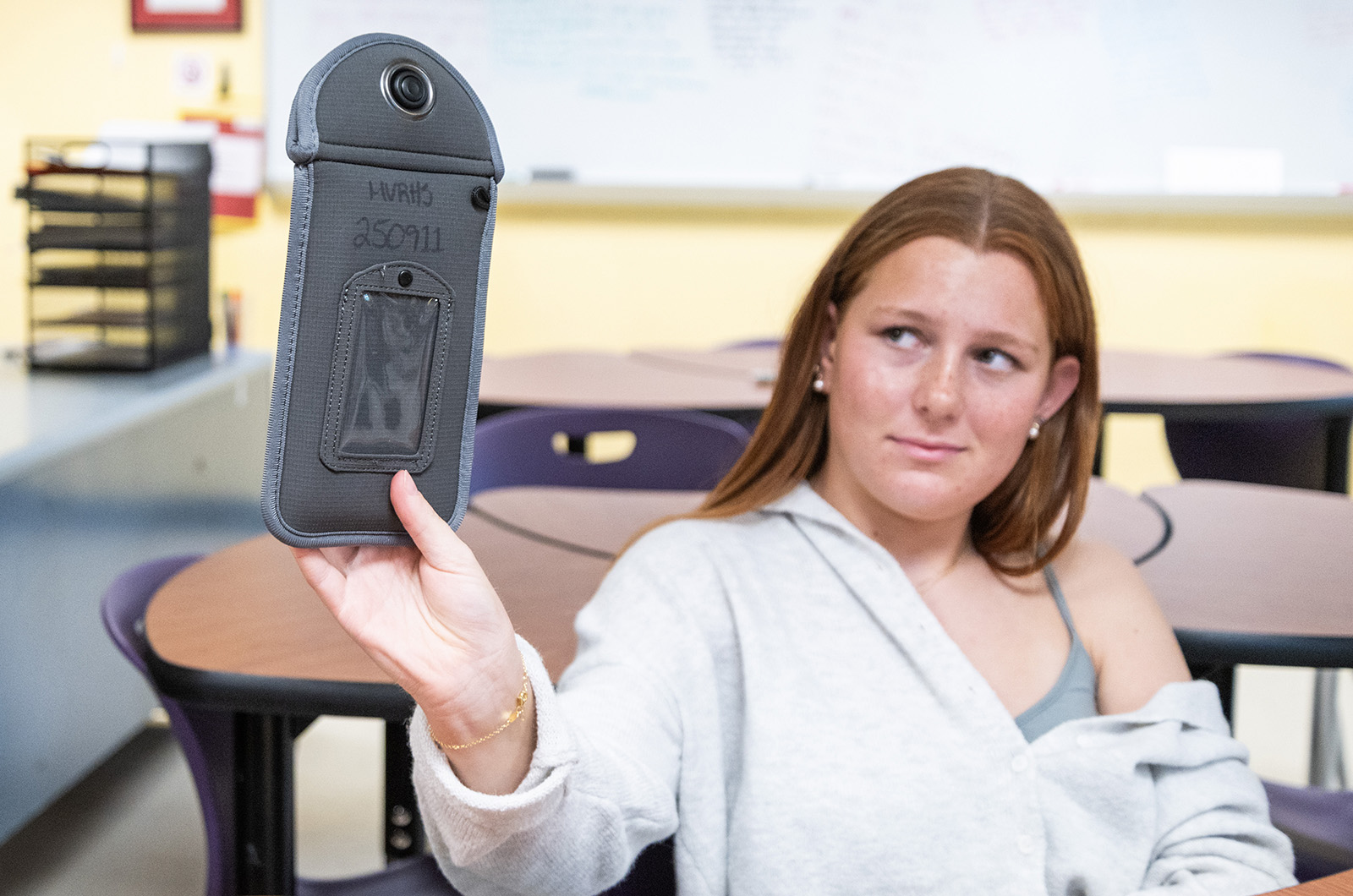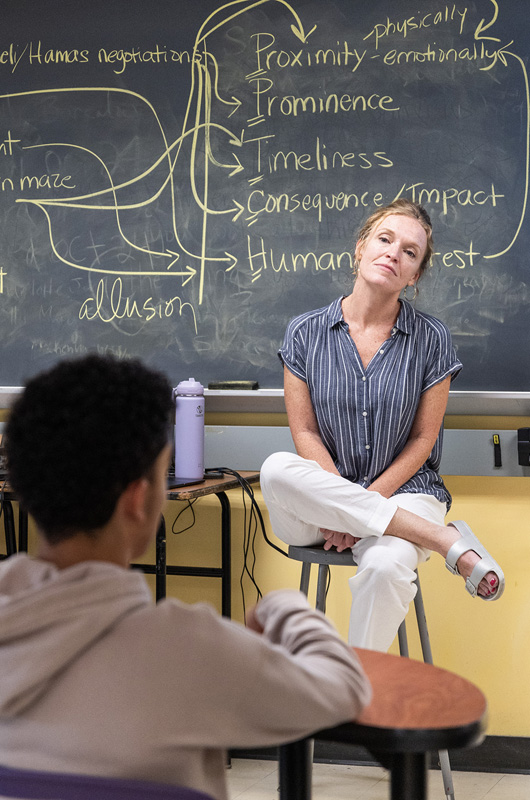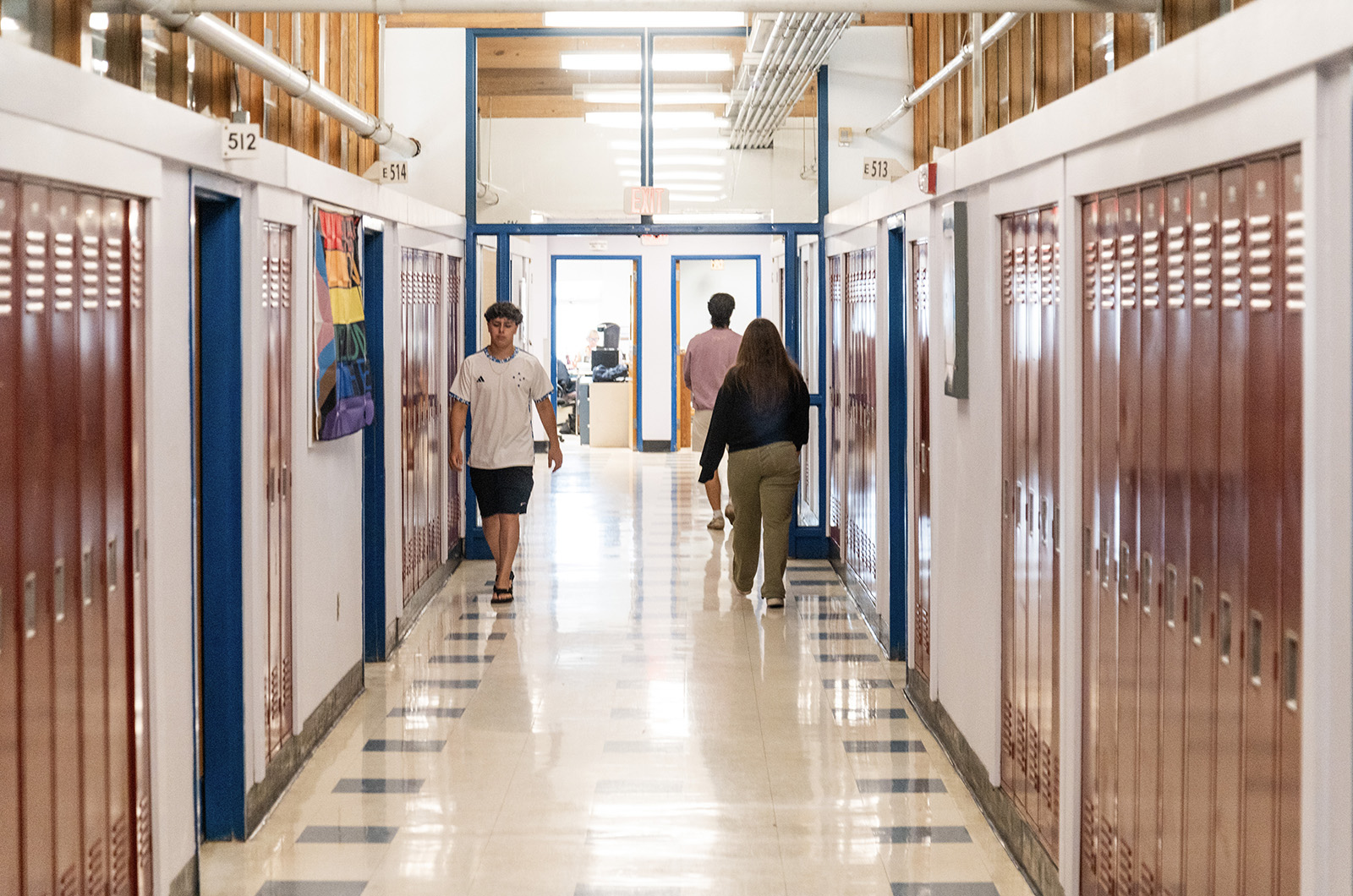When the bell rings at 7:30 a.m. at the Martha’s Vineyard Regional High School, students stuff their cell phones, earbuds and smart watches into small gray pouches, sealing them with a magnetic lock. The pouches are located at all four of the school’s entrances and on buses.
After that, students aren’t allowed access to their devices until the end of the school day. It’s part of the school’s new “Away For The Day” policy, begun this year in an effort to help students disconnect from their phones, focus in class and engage in conversations with their teachers and peers.
As the third week of school wraps up, students have mixed feelings about the new policy. Some said they’re more focused in class and connected to their classmates, while others said they think the restriction is too extreme and anxiety-inducing.
“We spent a lot of time trying to make sure that students knew it wasn’t punitive, but it was more about trying to promote a positive culture,” said Sara Dingledy, principal of the high school. “I think we were all pleasantly surprised at how flexible and adaptable the students were.”
The high school pouches, made by the company Yondr, can be opened by staff with a specific magnetic key. But just over two weeks into the new policy, students have already found a way to open the pouches themselves.
Nina Warren, a freshman who went to the West Tisbury School last year where students also had Yondr pouches, said students can look-up YouTube videos that tell them how to open the pouches without a teacher’s help. Other students chimed in and said if you hit it hard, the magnet will give way.
Ms. Dingledy said staff has always known that students would find a way to open the pouches themselves.
“We’ve caught a few kids, and then their parents have to come get their phone, and then they can’t bring their phone into the school day,” Ms. Dingledy said. “I think nothing is sadder than a student who’s hacked into a Yondr pouch and is hiding out in the bathroom stall to be on their phone . . . if that were the case, I just think we’d try and get that person support.”
Ms. Dingledy said students are also prohibited from using their personal laptops at school, which she described as big phones because of their ability to text and log in to social media. All students have been issued Chromebooks this year; on the books, certain websites are blocked by school administrators and the only means of communication is Gmail.
English teacher Kathryn Hennigan said she’s noticed a positive difference in her students’ attention. But she said the biggest change is in the hallways and during class down time.
“The first week of school, I said ‘hi’ to more former students in the halls than I’ve said hi to since we’ve been back from Covid-19,” Ms. Hennigan said. “I was able to because they’re not in the halls looking down at their phones.”
Ms. Hennigan said that while many people are addicted to their phones, teenagers are more vulnerable because their brains aren’t fully developed. In her eyes, educators have a responsibility to do something.
“The daily threat of dopamine addiction and the ways in which it is impairing cognitive ability is of such great concern to us as educators,” she said.
Freshman Hitallo Moreira said he thinks the school should be teaching students how to find a healthy balance with their devices, rather than banning screens completely.
“We should all learn how to manage our usage of technology ourselves, instead of [phones] being forced away,” he said. “Everyone thinks differently. Everyone learns differently. If you take [the phone] away from some people, it’s just going to encourage them to want to use it even more.”
Ms. Hennigan said she used to spend five minutes before every class collecting phones and making sure she had her students’ full attention. When there was down time in class, she said her students used to silently scroll on their phones. But with the new policy, she said students are talking to one another and even playing games.
There are a few exceptions to the no-phones rule. Ms. Dingledy said students who need their devices for medical needs are allowed to have them. Any student who needs to message their parents can go to the front office, where she said a staff member will let them use a land line phone or unlock their pouch.
But many students didn’t know that was an option. When surveyed informally, only one student out of the nine in Ms. Hennigan’s introduction to journalism class said they were told by staff that they had the option to go to the office and make a call.
Hitallo, who did not raise his hand when asked if he knew he could make a call at the office, said he thinks leaving class to access his phone is inconvenient.
“Some rooms are not that close to the office,” he said. “You have to walk all the way there and you’re missing class time.”
As the policy continues, Ms. Dingledy said staff is closely monitoring how limited access to personal devices is affecting student anxiety.
Amy Lilavois, a guidance counselor for the school, said she hasn’t had any students come to her with anxiety about the new policy and that the number of students seeking counseling has not changed.
“The atmosphere in this building is exactly what we wanted it to become,” Ms. Lilavois said.
Ms. Lilavois said some students have expressed relief over the new policy and they appreciate getting a break from social media. The only negative thoughts she said students have shared with her were about the noise levels from increased conversing at lunch and in the hallways.
Junior Anina Garvin said she’s noticed a difference in her anxiety levels and appreciates how the policy has given her a break from her phone.
“I am just so much more focused in school,” Anina said. “I’ve gotten so much more work done.”
Last year without the policy, Anina said she would go on her phone during class, miss important information and fall behind on work. She said she often gets overwhelmed with social media in particular, something the policy has helped her realize.
Inspired by how freeing the policy made her feel, Anina went home after school on Tuesday and deleted her TikTok app.
Her classmate, freshman Rita Hurley, had a different take.
“I’m not the kind of person who’s going to check [my phone] every two seconds, but being able to have it and knowing I can grab it if I need it is comforting,” Rita said. “Having them locked away or just not bringing it because I know that it’s going to be locked is honestly anxiety provoking.”
Some students in Ms. Hennigan’s class said they haven’t been told what to do with their pouches in the event of an emergency.
“If I really need to, God forbid, text my last goodbyes . . .” Rita said, “I’m gonna rip the thing open.”
Ms. Dingledy said in the event of an emergency, the school’s main concern is getting students to a safe place. She said research shows that when students stop to text during an emergency, their safety is more at risk.
“If you’re thinking about safety first, to me, that’s more paramount than facilitating the ability for people to get in touch with one another during an emergency,” Ms. Dingledy said.
As the policy evolves, Ms. Dingledy said she welcomes feedback from students, parents and teachers.











Comments (3)
Comments
Comment policy »